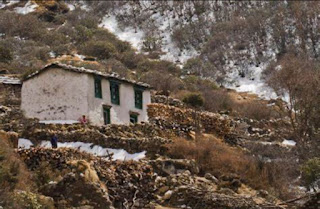In the spring trekking season of 1973, we spent three weeks trekking from the tiny village of Jiri, a one day bus journey from Kathmandu, to Tengboche Monastery. The monastery was situated at 13,000 feet and Mount Everest Base Camp was a further 5,000 foot trek at 18,000 feet.
We had planned to trek all the way to Base Camp, but were advised against it at Tengboche because an Italian Army expedition, using a massive heard of yaks to portage their equipment, had trampled a virtual canyon through deep snow, making conditions dangerous for trekkers without proper high altitude down clothing.
We chose to travel without guides or porters, carrying 35 & 40 pound backpacks respectively, with our sleeping bags, a few food staples our tiny camp stove, but no tent.
Each evening we would walk through a pre-planned village at the end of a strenuous day’s trek to determine the most likely home from which to seek food and shelter. Some homes were obviously very poor, while others looked more affluent. A telltale welcome sign would often be an attractive hand made front door, more elaborate than the average rough hewn plank doors of the neighbouring cottages.
We would knock on the door of the chosen house and sign fingers to mouth and palm to ear - the universal language requesting food and a bed for the night. The return sign, fingers held up, would display the price in rupees. We never had to barter as the prices were always extremely generous compared to the prices we had paid throughout South East Asia and India.
Most Sherpa homes were two stories, with an animal barn and firewood storage downstairs and family accommodation upstairs. In the middle of the upstairs floor would be a mud and stone hearth and an open fire used for cooking, heating and light. The host would serve our meal by the fire then family and guests would bed down for the night around the fire.
One day while crossing a high plateau we misjudged time and distance and failed to arrive in the pre-planned village until well after dark. A lone dim light guided us the final mile or so of the day’s trek to a tiny remote village off the main trail.
By the time we arrived, the entire population had retired for the night. We knocked tentatively on the door of the cottage with the lone light flickering from a window and signed our needs. The man who greeted us shook his head, then beckoned us to follow him.
We approached another stone cottage and waited in the darkness while he knocked on the door, rousing the owner from her bed. The lone occupant, a gnarled old woman with a heavily lined face and leathery hands from a lifetime of toil, beckoned us into her humble abode. She set about stoking her fire in the middle of the floor and prepared a meal of rice and greens. After the meal she silently gestured for us to bed down by the fire and retired to her own bedroll nearby.
Next morning after a simple breakfast we asked our host if there were any chores that we could help her with. When we learned that she was setting out for a morning of firewood gathering we offered to come along. It took a couple of hours to gather two large bundles of sticks, with nothing available over 1” in diameter. The surrounding area had been scoured for firewood for centuries, requiring ever more diligent searching for a bundle of sticks capable of fuelling the evening cooking and heating fire.
Our host and I each hoisted a bundle onto our backs, and using traditional head bands to secure them we hiked back to the cottage. When we arrived, our host deftly threw her bundle off her back. When I attempted to mimic her, my bundle tore the entire back out of my well worn Levi denim shirt, to which we all enjoyed a good laugh.
Shortly thereafter we bid our host farewell and continued on our way. The memory of the trust, kindness and generosity of that dear lady remains with us to this day.

No comments:
Post a Comment
We'd love to hear from you!